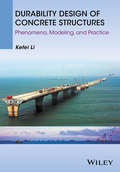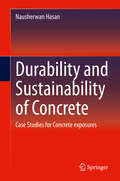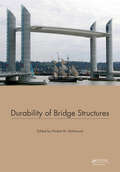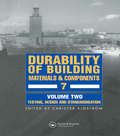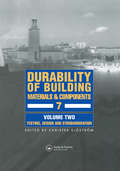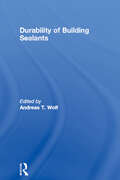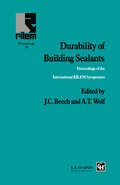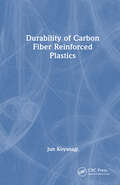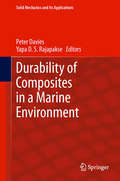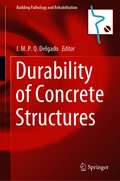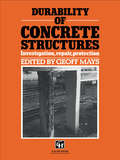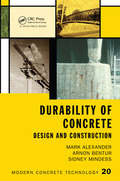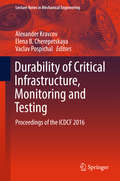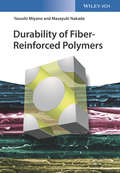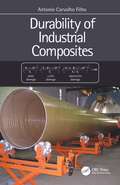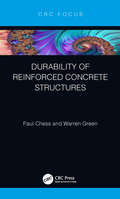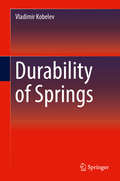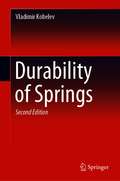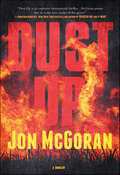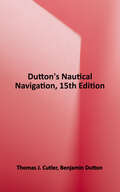- Table View
- List View
Durability Design of Concrete Structures: Phenomena, Modeling, and Practice
by Kefei LiComprehensive coverage of durability of concrete at both material and structural levels, with design related issues Links two active fields in materials science and structural engineering: the durability processes of concrete materials and design methods of concrete structures Facilitates communication between the two communities, helping to implement life-cycle concepts into future design methods of concrete structures Presents state-of-the-art information on the deterioration mechanism and performance evolution of structural concrete under environmental actions and the design methods for durability of concrete structures Provides efficient support and practical tools for life-cycle oriented structural design which has been widely recognized as a new generation of design philosophy for engineering structures The author has long experience working with the topic and the materials presented have been part of the author's current teaching course of Durability and Assessment of Engineering Structures for graduate students at Tsinghua University The design methods and approaches for durability of concrete structures are developed from newly finished high level research projects and have been employed as recommended provisions in design code including Chinese Code and Eurocode 2
Durability and Sustainability of Concrete: Case Studies for Concrete exposures
by Nausherwan HasanThis book provides practicing engineers with a step by step approach for making durable concrete with optimum use of the local materials available within the various regions of the United States. It further includes actual concrete mixture proportions for high performance concrete for strength and durability under various aggressive environments based on the author’s experience in the field, and support this with illustrative case studies. Examples for concrete mixture proportions, based on the current industry practice and standards, are highlighted to assist engineers in meeting the intended performance requirements (for specific environment conditions) for durable concrete. Covering an important topic for the construction and building materials industries, this book delivers the most up-to-date industry practices and advances in concrete construction from the perspective of a practicing engineer with over 40 year experience.Maximizes practicing engineers’ understanding of best design and construction practices in fabricating, delivery, and installation of concrete, consistent with current knowledge on concrete durabilityDiscusses quality control and testing requirements during design and construction, including mixing, production, and placement of concrete and tolerances for slump and air contentEmphasizes real-world examples of optimal concrete mixtures, suitable for selected service conditions and applications, based on prior successful records of projects within the USAddresses the role of innovative admixtures in concrete placement in cold weather conditions below 32F and meeting the strength and durability requirementsServes as a valuable resource for students in graduate programs
Durability of Bridge Structures: Proceedings of the 7th New York City Bridge Conference, 26-27 August 2013
by Khaled M. MahmoudOn Thursday evening, May 23, 2013, the Interstate 5 Bridge over the Skagit River in Washington state collapsed due to impact by an oversize truck, dumping vehicles and people into the water. Fortunately, the bridge is located in a rural area and nobody was killed in the accident, but three people were rescued after their cars plunged into the frigi
Durability of Building Materials & Components 7 vol.2
by Christer SjFirst Published in 2004. In the process of harmonising the wide-ranging interests in this field, the series of international conferences Durability of Building Materials and Components, of which this is the seventh, has played a decisive role by bridging between different material and product areas and by giving researchers and practitioners an opportunity to meet every third year to discuss the latest R&D achievements. This conference covers a number of themes ranging from theoretical aspects of service life prediction to the practical implementation of knowledge on durability of building products in standards. This collection is the proceedings and will serve as a valuable reference to all interested in the wide and stimulating area of durability and service life prediction in building and construction. This is Volume Two on Testing, Design and Standardisation.
Durability of Building Materials and Components
by Vasco Peixoto Freitas J.M.P.Q. DelgadoDurability of Building Materials and Components provides a collection of recent research works to contribute to the systematization and dissemination of knowledge related to the long-term performance and durability of construction and, simultaneously, to show the most recent advances in this domain. It includes a set of new developments in the field of durability, service life prediction methodologies, the durability approach for historical and old buildings, asset and maintenance management and on the durability of materials, systems and components. The book is divided in several chapters that intend to be a resume of the current state of knowledge for benefit of professional colleagues.
Durability of Building Materials and Components 7: Proceedings of the seventh international conference
by Christer SjöströmThese books contain articles on R&D into the major aspects of durability and service life prediction of building materials and components, as well as theoretical aspects of methods and modelling of prediction, description of degradation environment by use GIS, as practical implementation of knowledge on durability in maintenance procedures and in standardisation and regulations.
Durability of Building Sealants: 4th Volume
by A. T. WolfThis volume contains the proceedings of the Second International Symposium on Durability of Building Sealants, held under the joint auspices of the British Building Research Establishment Ltd (BRE) and the International Union of Testing and Research Laboratories for Buildings and Structures (RILEM) Technical Committee 139-DBS. The twelve contributions in this volume reflect the wide spectrum of current research and provide for the development of an International Standard on Sealant Durability.
Durability of Building Sealants: 4th Volume
by J.C. Beech A.T. WolfThis book presents the papers given at the RILEM Seminar held at the Building Research Establishment, Garston, UK in October 1994. The book provides an opportunity for researchers to review up-to-date progress towards the achievement of the objectives of the standardisation of laboratory techniques of sealants in the variety of service conditions to which they are exposed.
Durability of Building Structures and Constructions from Composite Materials: Russian Translations Series 109
by V. Sh. Barbakadze V.V. Kozlov V.G. Mikul'skii I.I. NikolovThis text deals with the estimation, prediction and improvement of the durability of building structures and constructions from composite materials with inorganic, organic and mixed binders. It describes a method for improving the durability of structures and constructions.
Durability of Carbon Fiber Reinforced Plastics
by Jun KoyanagiKoyanagi presents a concise and practical guide to using a micromechanics approach to predict the strength and durability of unidirectionally aligned continuum carbon fiber reinforced plastics (CFRPs).As the use of composite materials in becomes more widespread in various fields, material durability is becoming an increasingly important consideration, particularly with regard to UN Sustainable Development Goals. Using more durable composite materials would help with achieving these goals. Because the failure of composite materials proceeds via the accumulation of micro failures and micro damage, a micromechanics approach is indispensable for estimating precise durability.In this practical guide, Koyanagi describes this approach and explains the precise durability of the composite materials with regard to the time dependence of micro failures. This book first explains the strength and durability of unidirectionally aligned continuum CFRPs. It then individually addresses fiber, resin, and the interface between the two on the basis of their micromechanics and introduces these components’ time and temperature dependences. Koyanagi uses finite element analysis and theoretical models to integrate the characteristics of the three components to explain the macro properties of the CFRPs. Various characteristics regarding strength and durability of CFRPs are also presented.This book is a valuable resource for researchers in academia and industry who work with composite materials. It will enable them to design composite structures, ensure their durability, evaluate them, and develop more durable composite materials.
Durability of Composites in a Marine Environment
by Peter Davies Yapa D.S. RajapakseComposites are widely used in marine applications. There is considerable experience of glass reinforced resins in boats and ships but these are usually not highly loaded. However, for new areas such as offshore and ocean energy there is a need for highly loaded structures to survive harsh conditions for 20 years or more. High performance composites are therefore being proposed. This book provides an overview of the state of the art in predicting the long term durability of composite marine structures. The following points are covered: * Modelling water diffusion * Damage induced by water * Accelerated testing * Including durability in design * In-service experience. This is essential reading for all those involved with composites in the marine industry, from initial design and calculation through to manufacture and service exploitation. It also provides information unavailable elsewhere on the mechanisms involved in degradation and how to take account of them. Ensuring long term durability is not only necessary for safety reasons, but will also determine the economic viability of future marine structures.
Durability of Concrete Structures (Building Pathology and Rehabilitation #16)
by J. M. P. Q. DelgadoThis book provides a collection of recent research works, related to structural stability and durability, service life, reinforced concrete structures, recycled materials, and sustainability with endogenic materials. Intended as an overview of the current state of knowledge, the book will benefit scientists, students, practitioners, lecturers and other interested parties. At the same time, the topics covered are relevant to a variety of scientific and engineering disciplines, including civil, materials and mechanical engineering.
Durability of Concrete Structures: Investigation, repair, protection
by Geoff MaysThis book is concerned with the long term durability of concrete as a structural material as used in the construction of buildings, bridges, roads, marine and civil engineering structures. It discusses the fundamental reasons for the deterioration of concrete over time and available techniques for detecting, remedying and preventing the deteriorati
Durability of Concrete in Cold Climates (Modern Concrete Technology)
by M. Pigeon R. PleauThis comprehensive and authoritative review of durability of concrete in cold environments will enable concrete materials specialists and practising engineers to understand the mechanisms responsible for deterioration of concrete through freeze/thaw action.
Durability of Concrete: Design and Construction (Modern Concrete Technology #20)
by Mark Alexander Arnon Bentur Sidney MindessThis book provides an up-to-date survey of durability issues, with a particular focus on specification and design, and how to achieve durability in actual concrete construction. It is aimed at the practising engineer, but is also a valuable resource for graduate-level programs in universities. Along with background to current philosophies it gathers together in one useful reference a summary of current knowledge on concrete durability, includes information on modern concrete materials, and shows how these materials can be combined to produce durable concrete. The approach is consistent with the increasing focus on sustainability that is being addressed by the concrete industry, with the current emphasis on ‘design for durability’.
Durability of Critical Infrastructure, Monitoring and Testing
by Alexander Kravcov Elena B. Cherepetskaya Vaclav PospichalThis book presents the proceedings of the International Conference on Durability of Critical Infrastructure. Monitoring and Testing held in Satov, Czech Republic from 6 to 9 December 2016. It discusses the developments in the theoretical and practical aspects in the fields of Safety, Sustainability and Durability of the Critical Infrastructure. The contributions are dealing with monitoring and testing of structural and composite materials with a new methods for their using for protection and prevention of the selected objects.
Durability of Fiber-Reinforced Polymers
by Yasushi Miyano Masayuki NakadaThe result of the authors' 40 years of experience in durability testing, this book describes the advanced testing methodology based on the viscoelasticity of matrix polymer. After a short introduction to the viscoelastic behavior of fiber-reinforced plastics, the text goes on to review in detail the concepts of static, fatigue and creep strengths in polymer composites. An application-oriented approach is adopted such that the concepts developed in the book are applied to real-life examples. Indispensable information for materials scientists and engineers working in those industrial sectors is concerned with the development and safe use of polymer composite-based products.
Durability of Industrial Composites
by Antonio FilhoDurability of Industrial Composites offers numerical and quantitative solutions to long-term composite failures that are useful to practicing engineers, researchers, and students. All modes of laminate long-term failure are contemplated, with resin toughness and environmental conditions considered. The book develops a simple unified equation to compute the load-dependent durability of laminates under the simultaneous action of cyclic and static loads. The load-independent durability and residual life of equipment immersed in corrosive chemicals are also discussed. The book presents a full discussion of the elusive strain-corrosion mode of failure as well as a complete solution to the durability issue of underground sanitation pipes. The currently accepted durability parameters of HDB, Sb and Sc are discarded as incorrect and replaced with the appropriate threshold parameters. The entirely new concept of the "anomalous failure" is fully discussed and solved. The effects of overpressure and spike strains, as well as of the operating temperature and moisture, are quantitatively evaluated and illustrated in numerical examples.
Durability of Reinforced Concrete Structures
by Warren Green Paul ChessReinforced concrete structures corrode as they age, with significant financial implications, but it is not immediately clear why some are more durable than others. This book looks at the mechanisms for corrosion and how corrosion engineering can be used for these problems to be minimized in future projects. Several different examples of reinforced concrete structures with corrosion problems are described and the various life enhancement solutions considered and applied are discussed. The book includes a chapter on the effectiveness of corrosion monitoring techniques and questions why the reality is at odds with current theory and standards. Specialist contractors, consultants and owners of corrosion damaged structures will find this an extremely useful resource. It will also be a valuable reference for students at postgraduate level.
Durability of Reinforced Concrete from Composition to Protection
by Carmen Andrade Joost Gulikers Rob PolderThis book presents key advances in the modeling of reinforcement corrosion and concrete durability. It also examines various further aspects of reinforcement corrosion and concrete durability, striking a balance between modeling and testing. Particular attention is paid to innovative treatments for avoiding deterioration, and to methods for modeling performance in a real environment. Some basic aspects related to non-destructive testing techniques are also discussed. Deterioration-related topics addressed in the book include the basis for modeling alkali-silica reactions, chloride diffusion and the development of concrete microstructure; measurement-related topics include cathodic protection, polarization resistance and resistivity. A combined approach using the AFM technique and polarization measurements is examined, and the relation between cracking and corrosion and the treatment of concrete with hydrophobes or innovative products such as hydrotalcite is also discussed.
Durability of Springs
by Vladimir KobelevThis book offers an advanced treatise of the mechanics of springs with focus on the springs for automotive industry. It demonstrates new and original results for the optimization of helical springs as well the design of disk springs and thin-walled springs and presents the new results for creep and relaxation of springs made of steel under high static loads. The fatigue of springs and weak link concept for cyclically loaded springs are enlightened. The closed form solutions of advanced problems allow the deeper understanding of spring mechanics and optimization of energy harvesters.
Durability of Springs
by Vladimir KobelevThis book highlights the mechanics of the elastic elements made of steel alloys with focus on the metal springs for automotive industry. The industry and scientific organizations study intensively the foundations of design of spring elements and permanently improve the mechanical properties of spring materials. The development responsibilities of spring manufacturing company involve the optimal application of the existing material types. Thus, the task entails in the target-oriented evaluation of the mechanical properties and the subsequent design of the springs, which makes full use of the attainable material characteristics. The book stands as a valuable reference for professionals in practice as well as an advanced learning resource for students of structural and automotive engineering
Dust Extraction and Handling in the Wood Industry (SpringerBriefs in Applied Sciences and Technology)
by Endre Magoss Zoltán Kocsis György SitkeiThis book examines a topic which is an indispensable part of any production line in the wood industry: the extraction, separation, handling of dust and chips, ensuring clean air in the workrooms, and avoiding health, fire and explosion risks. All scientific backgrounds of these problems are not fully known today, and efforts should be made to fill this gap. The work contains significant new derivations and calculation methods and experimental results to support design and evaluation methods such as particle size distributions depending on wood species and machining, terminal velocity of small wood particles, aerodynamics of suction hoods, a detailed analysis of particle separation in cyclones, selection and evaluation of separation efficiency for appropriate filter selection, energy consumption and transportation efficiency of pneumatic conveying, a comprehensive theory of transport ventilators. Several new details of dust explosion are also included. The calculation methods, practical solutions and recommendations are supported by physically well-established explanations providing long-lasting knowledge.
Dust Up: A Thriller (Doyle Carrick #3)
by Jon McGoranIn this outstanding international thriller by Jon McGoran, Detective Doyle Carrick is awakened in the middle of the night by frantic banging on his front door, followed by gunfire. Ron Hartwell, a complete stranger, is dying on his doorstep.A halfhearted investigation labels the murder a domestic dispute, with Miriam, Ron’s widow, the sole suspect. Doyle discovers the Hartwells both worked for a big biotech company and suspects something else is going on, but it’s not his case. Then Miriam tracks him down and tells him her story.Miriam and Ron had been working in Haiti and visiting her friend Regi Baudet, the deputy health minister, when they stumbled upon a corporate cover-up of tainted food aid that sickened an entire village—and was one hundred percent fatal. They were coming to Doyle to blow the whistle. Before Miriam can say more, they are attacked by gunmen and she flees, then disappears.Doyle tracks her to Haiti, a country on the brink of political chaos. Working with Miriam and Regi, he must untangle a web of deceit and unconscionable corporate greed in order to stop an epidemic of even greater evil before it is released onto an unsuspecting world.At the Publisher's request, this title is being sold without Digital Rights Management Software (DRM) applied.
Dutton's Nautical Navigation, Fifteenth Edition
by Thomas J. CutlerAs paper navigational charts are replaced by vector images on computer screens, magnetic compasses enhanced by digital flux gate technology, and chronometers joined by atomic clocks, the demand has been mounting for an extensive update to the classic reference known worldwide as Dutton's. To meet the varied needs of today's recreational, naval, and commercial navigators, the Naval Institute introduces this new edition of a guide that has remained the seafarers' choice for more than three-quarters of a century. It blends the traditional navigation techniques first compiled by Benjamin Dutton in 1926 with technological marvels of the twenty-first century to authoritatively cover all phases of surface navigation. For example, while the book acknowledges that many navigators still peer into the skies through sextant telescopes, it also helps them take full advantage of man-made Global Positioning System (GPS) satellites. Valued as both an indispensable quick reference and a comprehensive text, Dutton's makes accessible such foreboding subjects as spherical trigonometry through the use of step-by-step explanations and examples that encourage practical use. To insure accuracy and relevancy, a board of experts made up of naval and Coast Guard officers, merchant mariners, accredited harbor pilots, and sea-service academy professors has carefully reviewed this fifteenth edition. The result is an unparalleled treatment of the art and science of nautical navigation that both amateur and veteran navigators will use to navigate the waters of the world safely.
